
www.icelandicsheep.com
Shearing Days Fall
2000

Icelandic
Sheep are sheared twice a year in order to harvest the best quality fleece. They
are a natural shedding breed, and in February the rams start loosing the thel or
undercoat. The outer coat or tog stays in place to protect them until their new
coat grows in. The ewes don't shed until May or June, putting all of their
energy into their developing lambs. If not sheared in the early spring, the
fleece will loosen and be rubbed off on fence and trees. Ancient shepherds
selected for this trait before shears were invented, in order to harvest more
fiber. Sheep were caught and the loose wool was plucked or 'rooed'. After the
advent of shears commercial breeds were bred for year around fleece growth.
Icelandic
sheep fleeces grow slowly during the summer but as fall approaches with cooler
temperatures and shorter day length, the sheep grow their fleeces very fast. By
late Oct or early Nov the fleeces are 8" to 10" or longer with a 4"
to
5" thel or undercoat. Up until this time the sheep are grazing fall
pastures and have not been fed hay. The fleeces are therefore clean and free of
vegetative matter, a spinners dream. We shear at this time to get prime fleeces,
We have this time slot reserved with our shearer Ralph McWilliams Ph#
406-232-2915 (Ralph is a full time shearer and shears over 10,000 sheep a year).
Ralph usually gets a 2nd shearer in to help get the flock of 300+ done in 2
days. We provide, a sheltered place, extension cords, food, a support crew and
holding pens. Charlie loads the chute, Emily worms and gives vaccinations and I
sweep the shearing floor between sheep. Charlie's wife Jeannie caters the food
and it is always the best part of shearing days ( home made beef stew, ham and
cheese sandwiches, and several different kinds of cookies). Dawn Ann and Corrine pick up the fleece,
skirt, shake out the 2nd cuts, identify the sheep it came from on a card and
individually bag each fleece. Rex prepares the shelters with hay and hay feeders,
puts food on the table for the crew and cleans up after lunch.
Rex also wanders around and
photographs the events, chatting with the crew and in general getting in the way
of everyone who is working.
It costs us
about $1000 to shear these sheep, including paying the shearers, the help,
and the food. Our shearer uses a 13 tooth comb to prevent cutting the sheep.
Shearers say these sheep shear like butter in the fall and can shear 30 to 40
sheep before they need to change cutters. The sheep are not docile like
commercial breeds of sheep however, and
shearer's say they are "wound up tight" and can slip out of the
shearer's hold if they get out of position. However the sheep are not mean like
other breeds that will try to bite. I try and get helpers that are
quiet and work the sheep gently. If the sheep are handled well they come onto
the shearing floor fairly calm and don't struggle too much. This year we separated
the colored sheep from the light or white ones and sheared them separately. This helped keep
the fleeces from getting contaminated with the fibers from a different colored fleece. The
sheared fleeces are stored in our barn.
Now my winter work begins. I take
fleeces one at a time and pick off all of the short fibers, vegetative matter
and stained parts. The best XX% of the fleeces (grade A Fleeces) are bagged in
clean clear plastic bags and sent to spinning customers. See page Fleece
. The grade B fleeces are sent to be made into yarn. See page Lopi
Yarn . The grade C fleeces, skirtings and the best of the belly wool is sent for
processing into felting batts. See page Felt.
The short 2nd cuts and manure tags are put on the
garden for mulch.
The
sheep are released as soon as they are sheared and wander down the
road to their pastures. This reduces their stress level immediately. I provide tunnel hut
shelters in the pastures, well bedded with hay and a full hay feeder placed in front of it. If it is rainy or windy the sheep can
eat without going away from the shelter. The sheep will be a bit cold at first
but toughen up with in a week. Their skin actually thickens quickly and helps to
protect them from the cold. They will grow about 2" of fleece within a
month. This is enough fleece to get them through a typical 30 below zero Montana winter with the
help of the tunnel hut shelters. The sheep are hardy and I have never yet had
any get sick or die from cold as long as they can get out of the rain, snow,
wind and can fill their bellies with good quality hay. Their rumens give off
heat so as long as they are filled with good hay they are able to stay warm.
In late March we again shear
to take off the winter grown fleece that is heavily contaminated with hay. If we
did not do this, the old fleece might cott or felt the tips of the new fleece.
This would ruin the new fleece which will be harvested in the Fall and is the
main clip. These are the photos from our recent Fall shearing. We dodged rain
and heavy dew and could only shear 50 to 100 a day as we had to wait for the
sheep to dry and the days were short. It took 4 days to get the flock done.
The pickups showed up for the work!
click
on these thumbnails to enlarge
 |
 |
 |
 |
 |
 |
 |
 |
 |
 |
 |
 |
 |
 |
 |
 |
 |
 |
 |
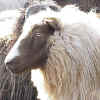 |

Charlie squeezes
sheep into the
chute |
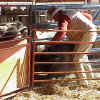
This one needed
help to find the
way into the chute |
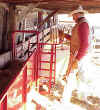
Charlie loading
the drenching
chute |

Everything is
under control in
Charlie's domain |
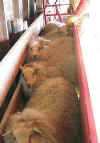
A load of white
girls in chute |
 |
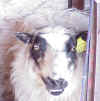 |
 |
 |

1579 doesn't
like the looks of it |
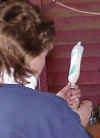 |

Emily with her
syringe at ready |

Emily giving a
vaccination
in the arm
pit. |

Emily giving a
dose of wormer |
 |
 |
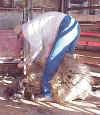 |

The view is good. |
 |
 |
 |
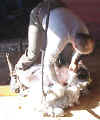 |
 |
 |
 |

Two shearers
working. |
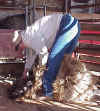 |
 |
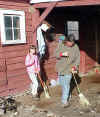
Spotless shearing
floor
|
 |
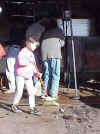
It's a big job to
keep the shearing
floor clean |
 |

Ely looks over
the new haircut. |
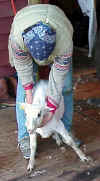
Susan and lamb |

The dogs take
a break. |

Dawn Ann
picking up fleece |

Skirting table |

Shaking out 2nd
cuts |

Skirting |

Skirting |

Glad that is over |

What happened? |

Saddle back
up close |

Saddle back |

Got Fleece? |

Bad hair day! |

Had to pee real
Bad. |

Ely and Ike |

Ely |

The tally counter |

Ralph's new
hand piece
'Goldie' |

Ralph's tools and
his felt shearing
slippers |

Lance's tools |
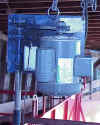
shearing motor |
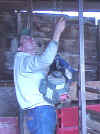
Taking down the
shearing motor |

|

bagging off fleece |

300+ fleeces |
|
|
|
|
|
|
|
|

Tongue River Farm
5000 CR 4910
Pomona, MO 65789
trf@icelandicsheep.com
|
All
photos, graphics, and text:
© Copyright Tongue River Farm, 2002 |














































































